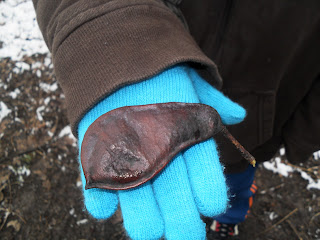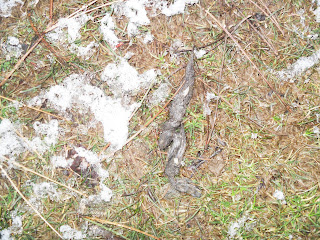1.2 miles completed
23.87 miles completed total
Today we hiked the Oxbow Trail. It is so named because it overlooks the oxbow of the Cuyahoga River. I have never been to this park and it is really beautiful. I think it will end up being one of my favorites. We learned so much today thanks to naturalist Mike Greene. He taught us how to identify trees without leaves by using other clues such as bark and twigs. I had always relied on leaves but today I realized leaves are really only the smallest part of the bigger picture. Some of my pictures didn't come out so I had to take some from the internet.
#1 Cottonwood
The cottonwood has rough bark with deep, wide, thick, straight, ridges. It grows mostly in stream valleys. It is in the poplar family along with aspens and has a fruit which splits and releases cottony seeds. Cottonwoods can be either male or female.
#2 Sycamore
The sycamore is also called the buttonwood because early pioneers would use the "button" from the seed pod. The bark near the top of a mature tree looks camouflaged. The hanging balls during winter are also distinctive. Here's a close-up of the seed ball.
The sycamore is also a tree that follows the stream and river valleys.
#3 Sugar Maple
The sugar maple is the tree that pioneers tapped for making maple syrup. This is also the point in the talk that we learned about opposite and alternate branch patterns. As far as native trees in this area go if the branch pattern is opposite they will follow this mnenomic device MAD HORSE BUCKS. MAD standing for Maple, ash, dogwood. Horse standing for horse chestnut which isn't actually native though in the cities there are quite a few; and bucks, representing buckeye which is the state tree. Everything else we will run into will be alternate. Now, back to the maples. If the tips this time of year are brown, think of brown sugar or syrup and you have your sugar maple. If it is red you have your red maple. And I don't remember what he said for silver maple :) Obviously this is an internet pic in case you didn't notice the green leaves. I don't know who to give credit to but thanks whoever you are, my pic didn't turn out and actually your pic is much nicer than mine was.
#4 American Hornbeam
This tree was used to make yokes for oxen back in pioneer time because it is a very hard wood.The name hornbeam comes from the fact that it would have been the beam between the horn of the oxen. Musclewood is probably the best common name because it will not be confusing like some of the other common names. This is an understory tree and will never reach great heights. It is usually found upland and rots quickly once it is down and comes in contact with water. The tree looks like a musclar forearm.
#5 Ash
Ash has diamonds in the bark with deep ridges and valleys. Ash trees generally grow near water and also upland. There upper branches are sturdier than maples.
Ash trees are considered threatened and it is estimated that unless treated they will not be around in 5-10 years. The emerald ash borer is a beetle from Asia that is decimating the ash population.
This is the seed from the ash. It looks similar to the tulip tree seed but the tulip tree seed has a little fin on it.
#6 Hawthorn

The only info I really got on this tree is that it has big thorns and some fruit. Sorry this is about all I'm able to tell you. My picture also did not come out so this is also a borrowed image.
#7 Tulip Tree. This is one of my favorites because I'm always able to identify it.
The bark is very flat and looks almost like it was painted with little white stripes. The tree grows very straight and tall. It is part of the magnolia family. The seed from the tulip tree looks a lot like an ash but has a little fin on it.

#8 White Oak
The shag doesn't curl up on the bottom. Humans can eat the acorns of the white oak bacause they don't contain as much tannen as other oaks so flour can be made from them. the leaves of the white oak group have rounded tips while the leaves from the red/black oak group have pointed leaf tips.
#9 Black Cherry
The Black Cherry Tree Bark looks like it has burnt corn flakes all over it. It has very rough bark. It is called a pioneer tree because animals spread the seeds by eating the fruit and depositing the seeds in their droppings. It is often easy to spot the "mother" tree and which trees came as results of the seeds being spread by other critters.
#10 Sassafras
Sassafras bark looks similar to cottonwood but has criss crosses and horizontal cuts in it. The wood underneath has an orange color and a strong smell. The extract from the root was used medicinally and used for tea.
#11 Red Maple
Red maples are opposite. They have thin branching and red new twig growth. Something on them is red in every season. Young bark is smooth and older bark starts to break up rougher. Some describe it as knees and elbows and some describe is as the heartbreak of psoriasis.
#12 Beech
Beech trees have smooth light bark. Trees can keep their leaves all winter though young trees tend to do it more than the older trees. The new buds are long and pointy.
#13 Dogwood
Dogwood also have opposite branches. Their bark is snakeskin like. They have thin twigs and are an understory tree. Leaf buds are thin but flower buds tend to look like chocolate chips. During the winter you can tell how well a tree will flower in the spring by how many flower buds it has.






































.JPG)
.JPG)
.JPG)
.JPG)